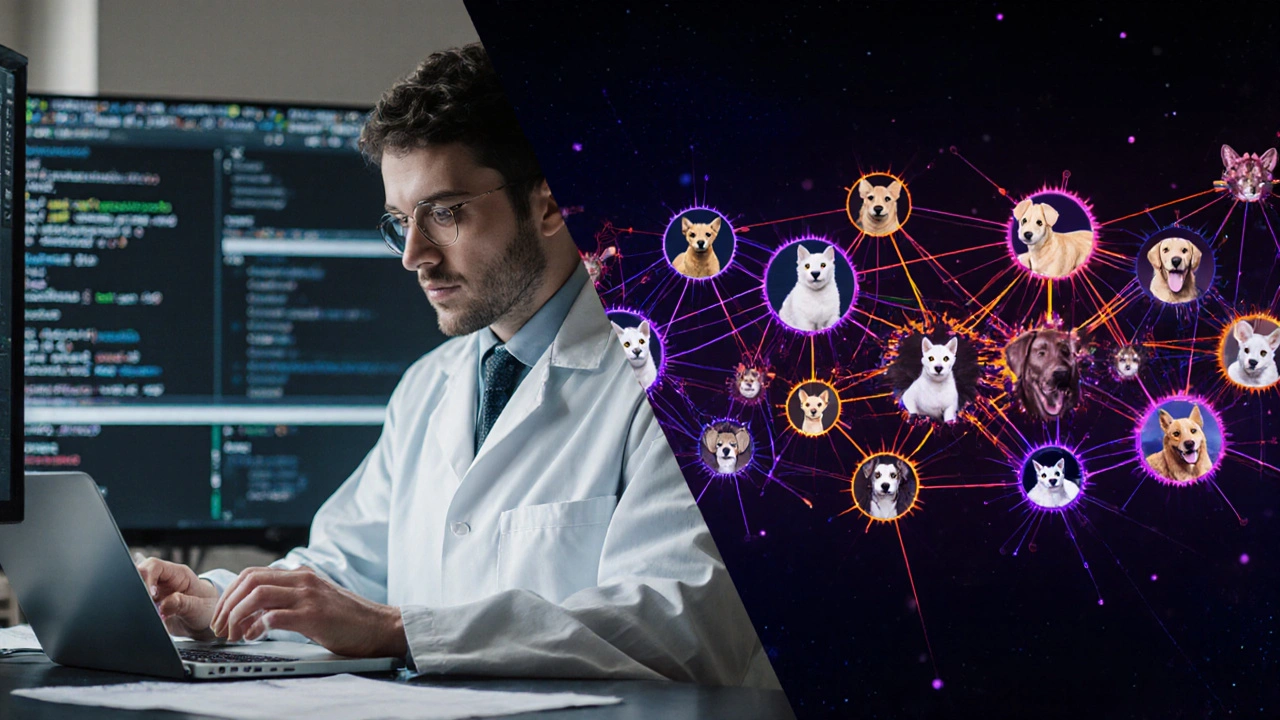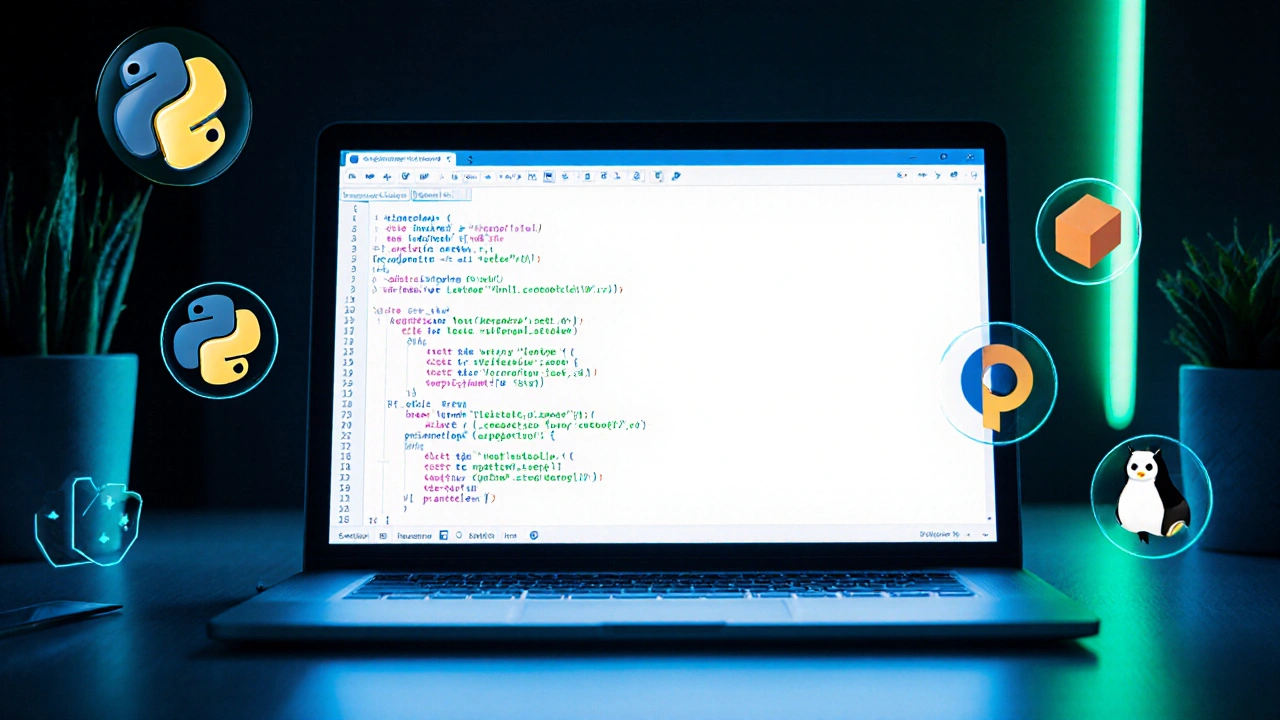Python Code Line Calculator
How Simple is Python for AI?
Discover how few lines of code you'd need to accomplish common AI tasks in Python versus other languages.
When you think of artificial intelligence, you might picture robots, self-driving cars, or chatbots that sound like humans. But behind every one of those systems? A lot of Python code. It’s not magic. It’s not luck. Python became the default language for AI because it just works-simply, reliably, and at scale.
Why Python? It’s Not About Being the Fastest
Python isn’t the fastest language out there. C++ runs circles around it. Rust is safer. Java is more structured. But none of them have the ecosystem Python built over 20 years for data and AI. Think of it like this: you don’t need the fastest car to win a race if you’ve got the best GPS, the smoothest roads, and a mechanic who can fix anything in five minutes. Python is that mechanic.
Libraries like TensorFlow, PyTorch, and scikit-learn didn’t just appear out of nowhere. They were built by researchers and engineers who wanted to stop rewriting the same math from scratch. They needed something that let them focus on the problem-not the syntax. Python gave them that. Today, over 90% of machine learning projects on GitHub use Python. That’s not a trend. That’s the standard.
How Python Makes AI Development Easier
Building an AI model isn’t like building a website. You’re not just arranging buttons and forms. You’re teaching a machine to recognize patterns in noise-like telling it what a cat looks like from 10,000 blurry photos. That’s messy. That’s complex. And Python handles it with surprising simplicity.
Take image recognition. With Python, you can load a pre-trained model in three lines:
from tensorflow.keras.applications import ResNet50model = ResNet50(weights='imagenet')predictions = model.predict(image)
That’s it. No compiling. No linking libraries manually. No wrestling with memory pointers. You just run it. And if something goes wrong? The error message actually tells you what’s wrong-instead of dumping 50 lines of cryptic C++ output.
Same goes for data cleaning. In other languages, you’d spend weeks writing loops to handle missing values. In Python, you use pandas. One line: df.dropna() removes all rows with empty data. Another: df['age'].fillna(df['age'].mean()) fills gaps with the average. It’s not just convenient-it’s faster than doing it by hand in Excel.
The Libraries That Power AI
Python’s strength isn’t the language itself. It’s the tools built on top of it. Here’s what you’ll actually use in real AI projects:
- NumPy - Handles numbers at scale. If your AI is doing math, it’s probably using NumPy under the hood.
- pandas - The go-to for loading, cleaning, and exploring data. Used in 87% of data science workflows according to a 2024 Kaggle survey.
- scikit-learn - The Swiss Army knife for traditional machine learning. Logistic regression, decision trees, clustering-all ready to use with a few imports.
- TensorFlow and PyTorch - The two giants for deep learning. TensorFlow is what Google uses for Search and Translate. PyTorch is what Meta uses for AI research and what most universities teach.
- Matplotlib and Seaborn - Turn numbers into pictures. If you can’t visualize your results, you can’t explain them to anyone.
These aren’t add-ons. They’re the foundation. And they all work together. You load data with pandas, clean it with NumPy, train a model with scikit-learn, then switch to PyTorch if you need a neural network. No switching languages. No rewriting code. Just keep going.

Real-World Examples You Can See Today
Don’t believe Python is powerful? Look around.
Netflix uses Python to recommend what you should watch next. Their recommendation engine runs on a mix of scikit-learn and custom Python scripts that analyze billions of viewing patterns. Spotify uses it to build your Discover Weekly playlist. Even your phone’s voice assistant? It’s likely powered by Python-trained models.
Healthcare? Researchers at Stanford used Python to train an AI that detects skin cancer from photos with accuracy matching dermatologists. In Australia, CSIRO used Python to predict crop yields using satellite images and weather data-helping farmers decide when to plant.
These aren’t lab experiments. They’re running right now, in production, handling real people and real money. And they’re all built with Python.
What Python Can’t Do (And When to Look Elsewhere)
Python isn’t perfect. It’s slow for heavy number crunching. If you’re building a real-time trading system that needs to process a million transactions per second, Python will choke. That’s why companies like Goldman Sachs use C++ or Java for their core engines.
Python also doesn’t run well on tiny devices. If you’re putting AI on a smart thermostat or a drone with a 1GB chip, you’ll need to convert your model to something lighter-like TensorFlow Lite or ONNX. But even then, you probably built the model in Python first.
So the rule is simple: Use Python to build and test your AI. Then, if you need speed or size, optimize the final version with another tool. But don’t start elsewhere. You’ll waste months.

Getting Started: Where to Begin
If you’re new to AI and you want to use Python, here’s the shortest path:
- Install Python 3.11 or 3.12 (don’t use 2.7-it’s dead).
- Install Jupyter Notebook-it lets you write code, see results, and explain your work all in one place.
- Run
pip install numpy pandas scikit-learn matplotlib. - Work through the Python for Data Analysis book by Wes McKinney-or free tutorials on Kaggle.
- Try building a simple model: predict house prices from size and location. Use scikit-learn. It takes a weekend.
Don’t jump into neural networks on day one. Start with linear regression. Understand how the model learns. Then scale up. Most people fail because they try to run before they can walk.
The Future Is Still Python
Will something replace Python for AI? Maybe. But not soon. New languages like Julia promise speed. Go has better concurrency. But they don’t have the libraries. They don’t have the community. They don’t have the tutorials, Stack Overflow answers, or open-source projects.
Python’s advantage isn’t technical. It’s cultural. Millions of people have learned it. Thousands of companies rely on it. Every new AI tool is built for Python first. If you learn Python for AI today, you’re not learning a tool-you’re learning the language of the field.
And that’s why Python and AI are a match made in programming heaven. Not because it’s the most powerful. But because it’s the most accessible. And in AI, accessibility wins.
Is Python the only language used for AI?
No, but it’s the most common. Other languages like R, Julia, and even JavaScript are used in niche areas. R is popular in statistics-heavy research. Julia is faster for heavy computations. But 9 out of 10 AI projects still use Python because of its libraries, community, and ease of use. If you’re starting out, Python is the safest bet.
Do I need to know advanced math to use Python for AI?
Not at first. You can build working models with just basic algebra and understanding what inputs and outputs mean. Libraries like scikit-learn hide the complex math. But if you want to improve models, tweak parameters, or understand why something failed, you’ll need to learn linear algebra, calculus, and probability. Start simple. Learn the math as you need it.
Can I use Python for AI on my laptop?
Yes-for small to medium projects. Training a model to recognize cats vs. dogs? Easy on a modern laptop. Training a model that understands human language from millions of text samples? That needs a GPU and cloud power. Most beginners start locally. When they hit limits, they move to Google Colab or AWS-both offer free or cheap access to powerful machines.
How long does it take to become proficient in Python for AI?
If you dedicate 10-15 hours a week, you can build your first working AI model in 4-6 weeks. That means loading data, cleaning it, training a model, and making predictions. Becoming truly confident-able to design models, debug issues, and optimize performance-takes 6-12 months of consistent practice. It’s not a sprint. It’s a habit.
What’s the difference between machine learning and deep learning in Python?
Machine learning uses algorithms like decision trees or support vector machines to find patterns in structured data-like sales numbers or customer demographics. Deep learning uses neural networks, often with layers of data, to find patterns in unstructured data-like images, speech, or text. In Python, you use scikit-learn for machine learning and TensorFlow or PyTorch for deep learning. They’re different tools for different jobs.
If you’re serious about AI, start with Python. Not because it’s flashy. But because it’s the most reliable way to get from idea to result-without getting lost along the way.

